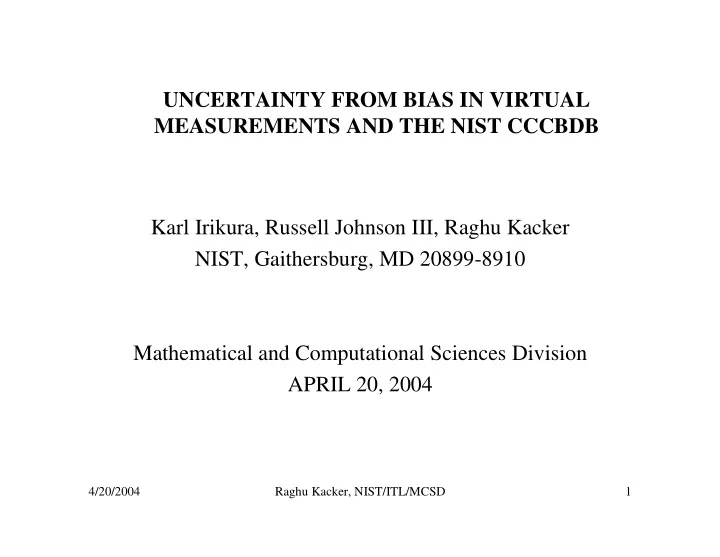

UNCERTAINTY FROM BIAS IN VIRTUAL MEASUREMENTS AND THE NIST CCCBDB Karl Irikura, Russell Johnson III, Raghu Kacker NIST, Gaithersburg, MD 20899-8910 Mathematical and Computational Sciences Division APRIL 20, 2004 4/20/2004 Raghu Kacker, NIST/ITL/MCSD 1
CONTENTS • Generic approach based on ISO Guide to quantify uncertainty from bias in a virtual measurement (Raghu) • Computational Chemistry Comparison and Benchmark Database (CCCBDB) developed by Russ Johnson of NIST – Estimated biases in virtual measurements from computational quantum chemistry models for many properties of many molecules • Our approach to quantify uncertainties in quantum chemistry based on ISO Guide and CCCBDB (Karl) 4/20/2004 Raghu Kacker, NIST/ITL/MCSD 2
ISO GUIDE ON EXPRESSION OF UNCERTAINTY • Virtual measurement: output of a computational model – Virtual = Calculated, Physical = Measured = Experimental • In computational chemistry, uncertainty arises mainly from bias relative to value of measurand • Before ISO Guide no generally accepted approach to quantify and incorporate uncertainty arising form bias • Also, some applications require both virtual and physical measurements • For physical measurements, ISO Guide de facto standard • In summary, ISO Guide is suitable for both virtual and physical measurements 4/20/2004 Raghu Kacker, NIST/ITL/MCSD 3
ACCOUNTING FOR UNCERTAINTY FROM BIAS • Y is value of measurand, x is virtual measurement, X is expected value and u ( x ) is standard deviation of x • Additive bias: X – Y , Fractional bias: X / Y • ISO Guide : correct x for its bias and include uncertainty associated with correction in combined uncertainty • Bias is a constant, but correction C for bias is a variable with state-of-knowledge distribution representing belief about required correction (negative/reciprocal of bias) • Expected value and standard deviation of C are c and u ( c ) • Corrected virtual measurement y for Y and uncertainty u ( y ) determined from x , c , u ( x ), and u ( c ) 4/20/2004 Raghu Kacker, NIST/ITL/MCSD 4
� � CORRECTION FOR BIAS • A measurement equation is required to apply correction – All quantities are variables with state-of-knowledge distributions • Measurement equation for additive bias: Y = X + C • y = x + c [ u 2 ( x ) + u 2 ( c )] • u ( y ) = • Measurement equation for fractional bias: Y = X × C • y = x × c 2 ( x ) + u r 2 ( c )] • u r ( y ) = [ u r • u r ( y ) = u ( y )/ y, u r ( x ) = u ( x )/ x, u r ( c ) = u ( c )/ c 4/20/2004 Raghu Kacker, NIST/ITL/MCSD 5
� � UNCERTAINTY IN VIRTUAL PREDICTIONS • Repeat evaluations of x give same result • So u ( x ) = 0 [ u 2 ( x ) + u 2 ( c )] = u ( c ) • Additive bias: u ( y ) = 2 ( x ) + u r 2 ( c )] = u r ( c ) • Fractional bias: u r ( y ) = [ u r • Thus u ( y ) = y u r ( y ) = y u ( c )/ c = x u ( c ) • Entire uncertainty arises from correction for bias 4/20/2004 Raghu Kacker, NIST/ITL/MCSD 6
USE OF CCCBDB FOR SPECIFYING c AND u ( c ) • CCCBDB is large collection of estimated biases in virtual measurements from quantum chemistry models – Estimated bias = x i – z i or x i / z i , where z i is high quality physical measurement corresponding to virtual measurement x i • Bias for target molecule is unknown • Suppose it is possible to identify a class of molecules in CCCBDB for which biases are believed to be similar to the bias in the target molecule – Scientific judgment • Then estimated biases for the matching class may be used to specify E ( C ) = c and S ( C ) = u ( c ) 4/20/2004 Raghu Kacker, NIST/ITL/MCSD 7
✁ � � � ✁ � � � CORRECTION c AND UNCERTAINTY u ( c ) • Suppose c 1 ,…, c m are estimated corrections in CCCBDB for matching class of molecules • Estimated correction for additive bias c i = z i – x i • Estimated correction for fractional bias c i = z i / x i • c = a i c i / a i a i [ c i – c ] 2 / • u ( c ) = { a i } • Many ways to specify a 1 , …, a m depending on application • Simple case: a i = 1, c = c A = c i / m [ c i – c ] 2 / m } • u ( c ) = s = { 4/20/2004 Raghu Kacker, NIST/ITL/MCSD 8
Recommend
More recommend